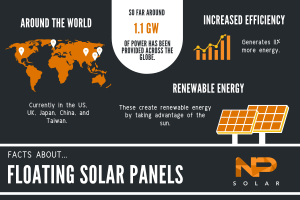Protecting our environment is more important than ever. The UK declared a climate emergency back in May this year, recognising the impact that climate change is having. Luckily there are new developments in place which aim to keep carbon emissions down and provide millions with energy.
At NP Solar our blog this week looks into how floating solar panels work and what is behind their success.
So, What is Floating Solar?
As more impact is felt across the world from climate change, new approaches to energy need to be used. One of these which has proved popular is the use of floating solar panels. Rather than placing a solar panel on land, this method uses pontoons to float a series of panels on water.
A huge benefit of this is that already scarce land resources can be left alone. Instead, we can make use of what is already there. Many countries have little space left, either due to expansion or geographic location. However, water bodies such as lakes and reservoirs are left almost untouched.
The relatively recent idea takes advantage of this space on top of water, creating an effective place for energy to be produced. In fact, floating solar farms have been seen to work better than land farms. The water beneath the panels keeps them cool, resulting in greater energy production and a decrease in evaporation of water. For many, this is a win-win situation.
How a Pontoon Works
Solar panels have been an established form of renewable energy for several years. However, the concept of floating them on water has not. These farms work by enabling the panels to safely sit on top of a body of water. A series of interconnecting plastic rafts provide a surface for solar panels to be attached to, keeping them safe.
Alongside this, floating walkways need to be constructed to provide access for any maintenance or servicing work that needs to take place.
Even though they are placed on water, this is usually manmade and inland. Unfortunately as it stands, floating solar pontoons are not able to be installed on the ocean as they cannot withstand the turbulent weather. Although, with plans for floating wind farms off the Cornish coast, this may be possible in years to come.

Current Success
As more countries begin to accept the impact of climate change, there has been an increase in the number of installations. The UK has set a date of 2050 as a deadline for reducing carbon emissions by 80% compared to levels in 1990. However, other local areas around the country have set a much earlier date of 2030.
With all that being said, what is being done and how is floating solar having an impact? In our local area of Lancaster, a floating farm was constructed on Langthwaite Reservoir by ourselves and United Utilities. The installation is made up of 3,520 panels over 7,200 square meters and will provide 1MW of power. On average, this is enough power for around 200 homes.
More countries around the world are adopting this method, including China, Taiwan and the US. According to research in the US, 1.1 GW (gigawatts) have been delivered around the globe, showing the impact that the installations are having.
What Does the Future Hold?
So far it seems that floating modular solar farms are going to keep gaining popularity. They provide energy in a cost-effective and environmentally friendly way. At NP Solar we provide installations across the UK, ensuring that there are alternatives to current energy production.
If you would like to find out more about pontoons and what else they can be used for, visit our other site.
